Binding and Synergizing Motif within Coleopteran Cadherin Enhances Cry3Bb Toxicity on the Colorado Potato Beetle and the Lesser Mealworm
Abstract
:1. Introduction
2. Results
2.1. Construction of Individual CR Regions for DvCad1-CR8-10 and Testing Enhancement of Cry3Bb Toxicity to CPB and LMW
2.2. Testing CR8, CR9, and CR10 for Enhancement of Cry3Bb Toxicity to CPB and LMW
2.3. CR8, CR9, and CR10 Peptides Bound Cry3Bb and Competed for the Same Binding Site on Cry3Bb
2.4. The N-Terminal Third of DvCad1-CR10 Binds Cry3Bb and Enhances Cry3Bb Toxicity to Coleopteran Larvae
2.5. A 26-Amino Acid (1254I - S1279) Peptide from Region A of CR10 Enhances Cry3Bb Toxicity
3. Discussion
4. Conclusions
5. Materials and Methods
5.1. Preparation of Cry3Bb Toxin and DvCad1 CR Peptides
5.2. Cloning Individual DvCad1-CR8, -CR9, or -CR10 Peptides from the DvCad1-CR8-10 Peptide
5.3. Deletions of the Cry3Bb-Binding Epitopes in DvCad1-CR10
5.4. Microplate Assays for Measuring DvCad1-CR Fragment Binding to Cry3Bb Toxin
5.5. Insect Bioassays
5.6. Insect Bioassays with DvCad1 N-Terminal Region (1254T - S1279) Peptide and Cry3Bb
5.7. Statistical Analysis
Author Contributions
Funding
Acknowledgments
Conflicts of Interest
Appendix A.
| Primer | Orientation | Primer DNA Sequence |
|---|---|---|
| Primers for construction of single cadherin fragments (DvCad1-CR8, -CR9, or -CR10) | ||
| DvCad1-CR8-F | Forward | 5’-CCCAgaattcCACCACCACCACCACCACTAAA-3’ |
| DvCad1-CR8-R | Reverse | 5’-CTGGgaattcAATGCTAGGGGTCTGGTAGTTCC-3’ |
| DvCad1-CR9-F | Forward | 5’-CCCAgaattcATTTTCCCAGAGAACGACCAGA-3’ |
| DvCad1-CR9-R | Reverse | 5’-CAGAaagcttAAAGATTGGCTGAGCATCGTTGTT-3’ |
| DvCad1-CR10-F | Forward | 5’-GCCAgaattcCAGAACTCTGACTGGTCTGTTTC-3’ |
| DvCad1-CR10-R | Reverse | 5’-TAAGgaattcCATATGTATATCTCCTTCTTAAAGTTAA-3’ |
| Primers for cloning of DvCad1-CR10 deletions (DvCad1-CR10/DelA, -CR10/DelB, or -CR10/DelC) | ||
| DvCad1-CR10/DelA-F | Forward | 5’-TTCTgaattcCTGTCTGTTATTGGTAACCTGAC-3’ |
| DvCad1-CR10/DelA-R | Reverse | 5’-CAACgaattcAACAGACCAGTCAGAGTTCTG-3’ |
| DvCad1-CR10/DelB-F | Forward | 5’-CGATgaattcGTACGCATGCTGGACCCA-3’ |
| DvCad1-CR10/DelB-R | Reverse | 5’-TCTGgaattcAGAGTAGAAATGGTAATAGAT-3’ |
| DvCad1-CR10/DelC-F | Forward | 5’-CCCAgaattcCACCACCACCACCACCACTAAA-3’ |
| DvCad1-CR10/DelC-R | Reverse | 5’-TACCgaattcAGACAGGTCACCAGAAGTCTC-3’ |
References
- Adang, M.J.; Brody, M.S.; Cardineau, G.; Eagan, N.; Roush, R.T.; Shewmaker, C.K.; Jones, A.; Oakes, J.V.; McBride, K.E. The reconstruction and expression of a Bacillus thuringiensis cryIIIA gene in protoplasts and potato plants. Plant Mol. Biol. 1993, 21, 1131–1145. [Google Scholar] [CrossRef] [PubMed]
- Perlak, F.J.; Stone, T.B.; Muskopf, Y.M.; Petersen, L.J.; Parker, G.B.; McPherson, S.A.; Wyman, J.; Love, S.; Reed, G.; Biever, D. Genetically improved potatoes: protection from damage by Colorado potato beetles. Plant Mol. Biol. 1993, 22, 313–321. [Google Scholar] [CrossRef] [PubMed]
- Alyokhin, A.; Baker, M.; Mota-Sanchez, D.; Dively, G.; Grafius, E. Colorado potato beetle resistance to insecticides. Am. J. Potato Res. 2008, 85, 395–413. [Google Scholar] [CrossRef]
- Ferro, D.N.; Lyon, S.M. Colorado Potato Beetle (Coleoptera: Chrysomelidae) larval mortality: Operative effects of Bacillus thuringiensis subsp. San Diego. J. Econ. Entomol. 1991, 84, 806–808. [Google Scholar] [CrossRef]
- Zehnder, G.W.; Gelernter, W.D. Activity of the M-One formulation of a new strain of Bacillus thuringiensis against the Colorado potato beetle: relationship between susceptibility and insect life stage. J. Econ. Entomol. 1989, 82, 756–761. [Google Scholar] [CrossRef]
- Adang, M.J.; Crickmore, N.; Jurat-Fuentes, J.L. Diversity of Bacillus thuringiensis Crystal Toxins and Mechanism of Action. In Advances in Insect Physiology: Insect Integument and Colour; Dhadialla, T., Gill, S., Eds.; Academic Press: Salt Lake City, UT, USA, 2014; Volume 47, pp. 39–87. [Google Scholar]
- Fabrick, J.A.; Wu, Y. Roles of insect midgut cadherin in Bt intoxication and resistance. In Bt Resistance: Characterization and Strategies for GM Crops Producing Bacillus Thuringiensis Toxins; CABI: Wallingford, UK; Boston, MA, USA, 2015; pp. 69–86. [Google Scholar]
- Fabrick, J.; Oppert, C.; Lorenzen, M.D.; Morris, K.; Oppert, B.; Jurat-Fuentes, J.L. A novel Tenebrio molitor cadherin is a functional receptor for Bacillus thuringiensis Cry3Aa toxin. J. Boil. Chem. 2009, 284, 18401–18410. [Google Scholar] [CrossRef] [PubMed]
- Contreras, E.; Schoppmeier, M.; Real, M.D.; Rausell, C. Sodium solute symporter and cadherin proteins act as Bacillus thuringiensis Cry3Ba toxin functional receptors in Tribolium castaneum. J. Biol. Chem. 2013, 288, 18013–18021. [Google Scholar] [CrossRef] [PubMed]
- Hua, G.; Park, Y.; Adang, M.J. Cadherin AdCad1 in Alphitobius diaperinus larvae is a receptor of Cry3Bb toxin from Bacillus thuringiensis. Insect Biochem. Mol. Biol. 2014, 45, 11–17. [Google Scholar] [CrossRef] [PubMed]
- Chen, J.; Hua, G.; Jurat-Fuentes, J.L.; Abdullah, M.A.; Adang, M.J. Synergism of Bacillus thuringiensis toxins by a fragment of a toxin-binding cadherin. Proc. Natl. Acad. Sci. USA 2007, 104, 13901–13906. [Google Scholar] [CrossRef] [PubMed]
- Soberón, M.; Pardo-López, L.; López, I.; Gómez, I.; Tabashnik, B.E.; Bravo, A. Engineering modified Bt toxins to counter insect resistance. Science 2007, 318, 1640–1642. [Google Scholar] [CrossRef] [PubMed]
- Pacheco, S.; Gomez, I.; Gill, S.S.; Bravo, A.; Soberon, M. Enhancement of insecticidal activity of Bacillus thuringiensis Cry1A toxins by fragments of a toxin-binding cadherin correlates with oligomer formation. Peptides 2009, 30, 583–588. [Google Scholar] [CrossRef] [PubMed]
- Park, Y.; Abdullah, M.A.; Taylor, M.D.; Rahman, K.; Adang, M.J. Enhancement of Bacillus thuringiensis Cry3Aa and Cry3Bb toxicities to coleopteran larvae by a toxin-binding fragment of an insect cadherin. Appl. Environ. Microbiol. 2009, 75, 3086–3092. [Google Scholar] [CrossRef] [PubMed]
- Sayed, A.; Nekl, E.R.; Siqueira, H.A.A.; Wang, H.-C.; ffrench-Constant, R.H.; Bagley, M.; Siegfried, B.D. A novel cadherin-like gene from western corn rootworm, Diabrotica virgifera virgifera (Coleoptera: Chrysomelidae), larval midgut tissue. Insect Mol. Biol. 2007, 16, 591–600. [Google Scholar] [CrossRef] [PubMed]
- Tan, S.Y.; Rangasamy, M.; Wang, H.; Vélez, A.M.; Hasler, J.; McCaskill, D.; Xu, T.; Chen, H.; Jurzenski, J.; Kelker, M. RNAi induced knockdown of a cadherin-like protein (EF531715) does not affect toxicity of Cry34/35Ab1 or Cry3Aa to Diabrotica virgifera virgifera larvae (Coleoptera: Chrysomelidae). Insect Biochem. Mol. Biol. 2016, 75, 117–124. [Google Scholar] [CrossRef] [PubMed]
- Park, Y.; Hua, G.; Abdullah, M.A.; Rahman, K.; Adang, M.J. Cadherin fragments from Anopheles gambiae synergize Bacillus thuringiensis Cry4Ba’s toxicity against Aedes aegypti larvae. Appl. Environ. Microbiol. 2009, 75, 7280–7282. [Google Scholar] [CrossRef] [PubMed]
- Hua, G.; Jurat-Fuentes, J.L.; Adang, M.J. Bt-R1a extracellular cadherin repeat 12 mediates Bacillus thuringiensis Cry1Ab binding and cytotoxicity. J. Biol. Chem. 2004, 279, 28051–28056. [Google Scholar] [CrossRef] [PubMed]
- Gomez, I.; Miranda-Rios, J.; Rudino-Pinera, E.; Oltean, D.I.; Gill, S.S.; Bravo, A.; Soberon, M. Hydropathic complementarity determines interaction of epitope (869)HITDTNNK(876) in Manduca sexta Bt-R(1) receptor with loop 2 of domain II of Bacillus thuringiensis Cry1A toxins. J. Biol. Chem. 2002, 277, 30137–30143. [Google Scholar] [CrossRef] [PubMed]
- Ruiz-Arroyo, V.; García-Robles, I.; Ochoa-Campuzano, C.; Goig, G.; Zaitseva, E.; Baaken, G.; Martínez-Ramírez, A.; Rausell, C.; Real, M. Validation of ADAM10 metalloprotease as a Bacillus thuringiensis Cry3Aa toxin functional receptor in Colorado potato beetle (Leptinotarsa decemlineata). Insect Mol. Biol. 2017, 26, 204–214. [Google Scholar] [CrossRef] [PubMed]
- Walters, F.S.; Stacy, C.M.; Lee, M.K.; Palekar, N.; Chen, J.S. An engineered chymotrypsin/cathepsin G site in domain I renders Bacillus thuringiensis Cry3A active against Western corn rootworm larvae. Appl. Environ. Microbiol. 2008, 74, 367–374. [Google Scholar] [CrossRef] [PubMed]
- Craig, T.J.; Ciufo, L.F.; Morgan, A. A protein-protein binding assay using coated microtitre plates: increased throughput, reproducibility and speed compared to bead-based assays. J. Biochem. Biophys. Methods 2004, 60, 49–60. [Google Scholar] [CrossRef] [PubMed]
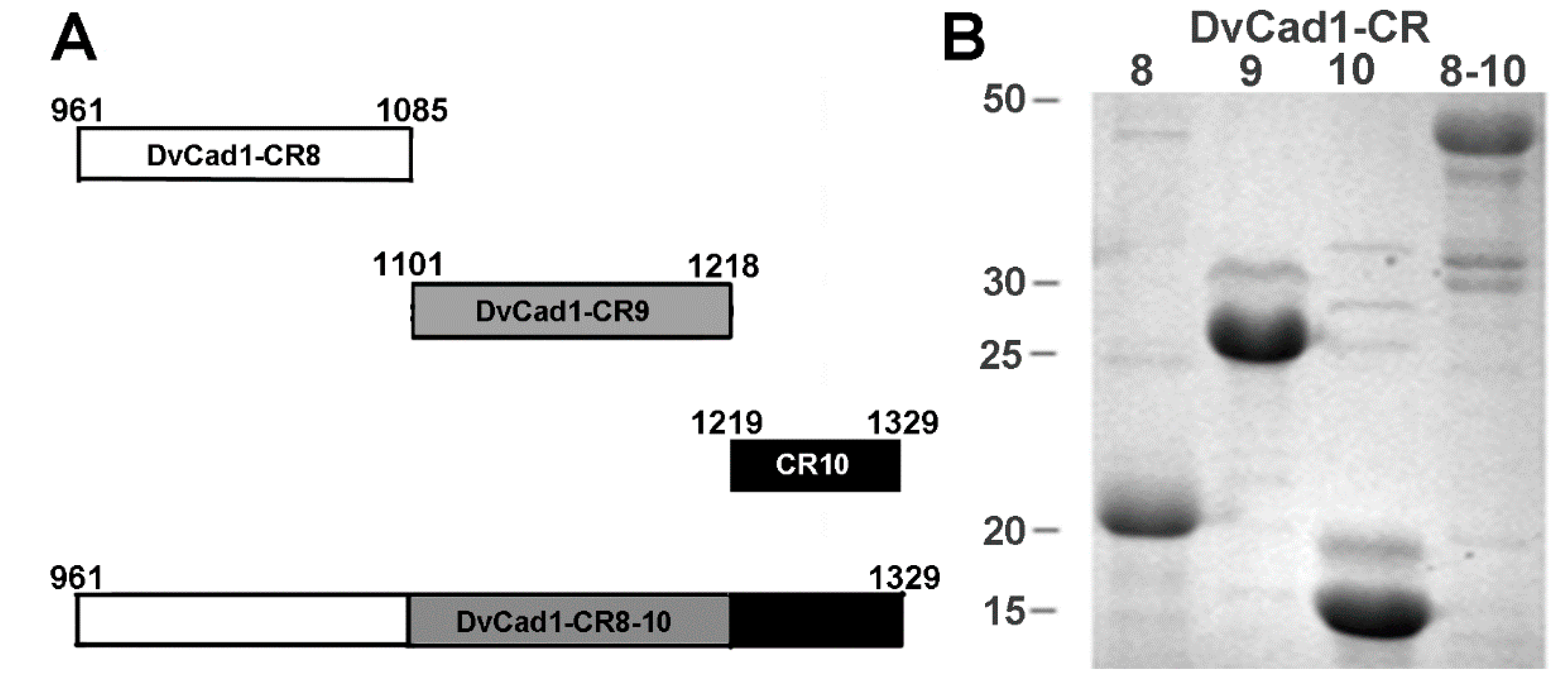
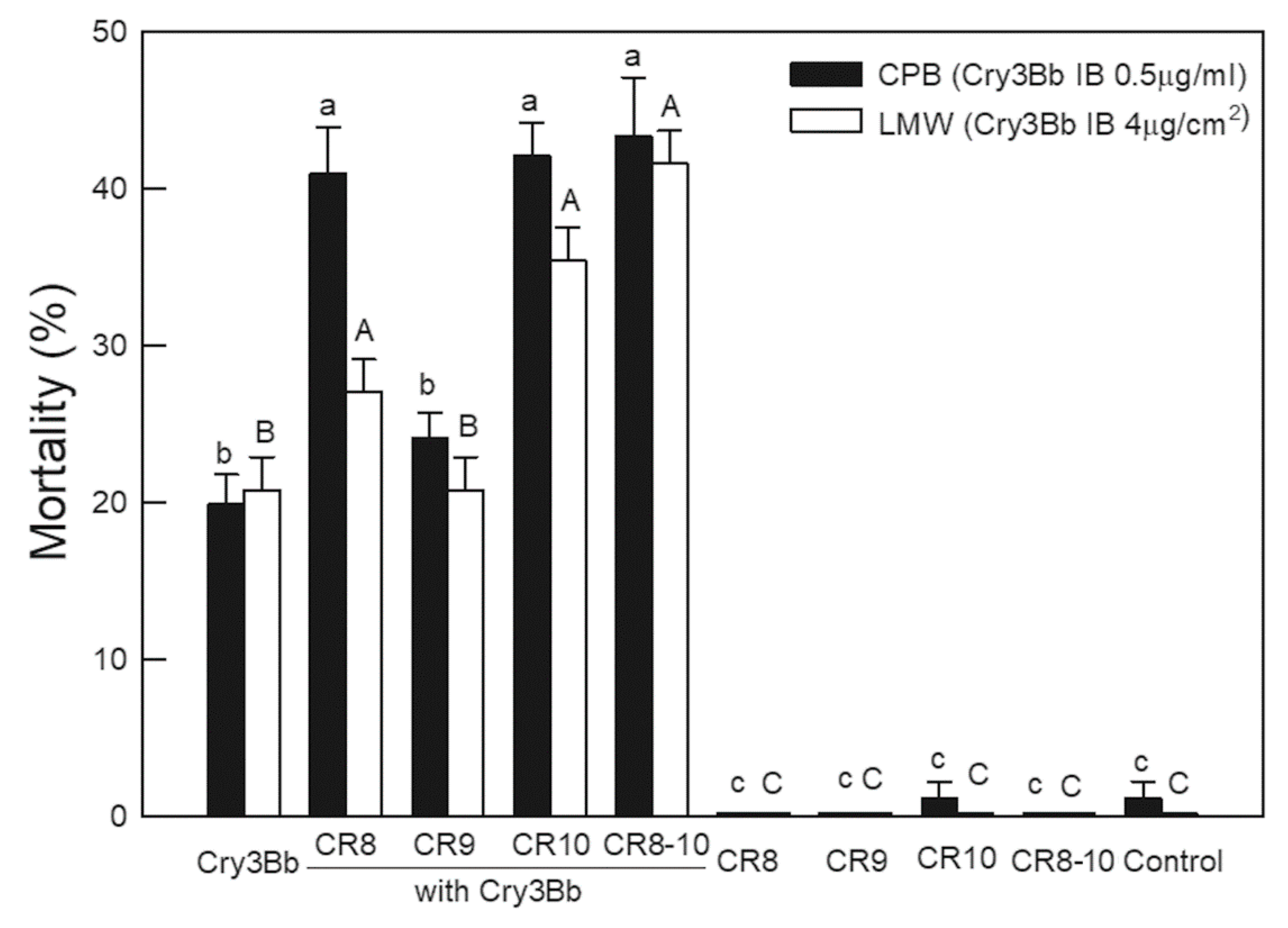
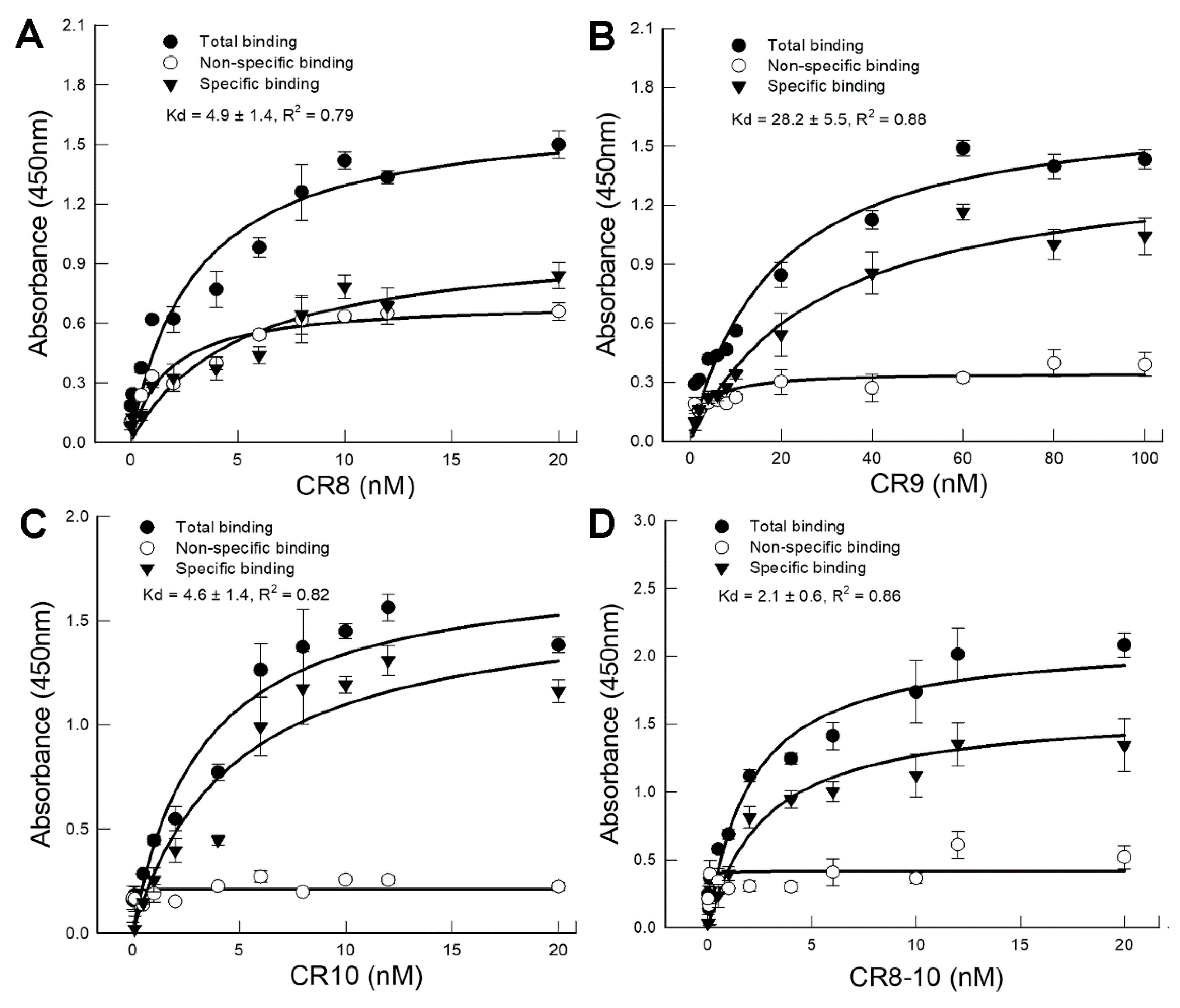

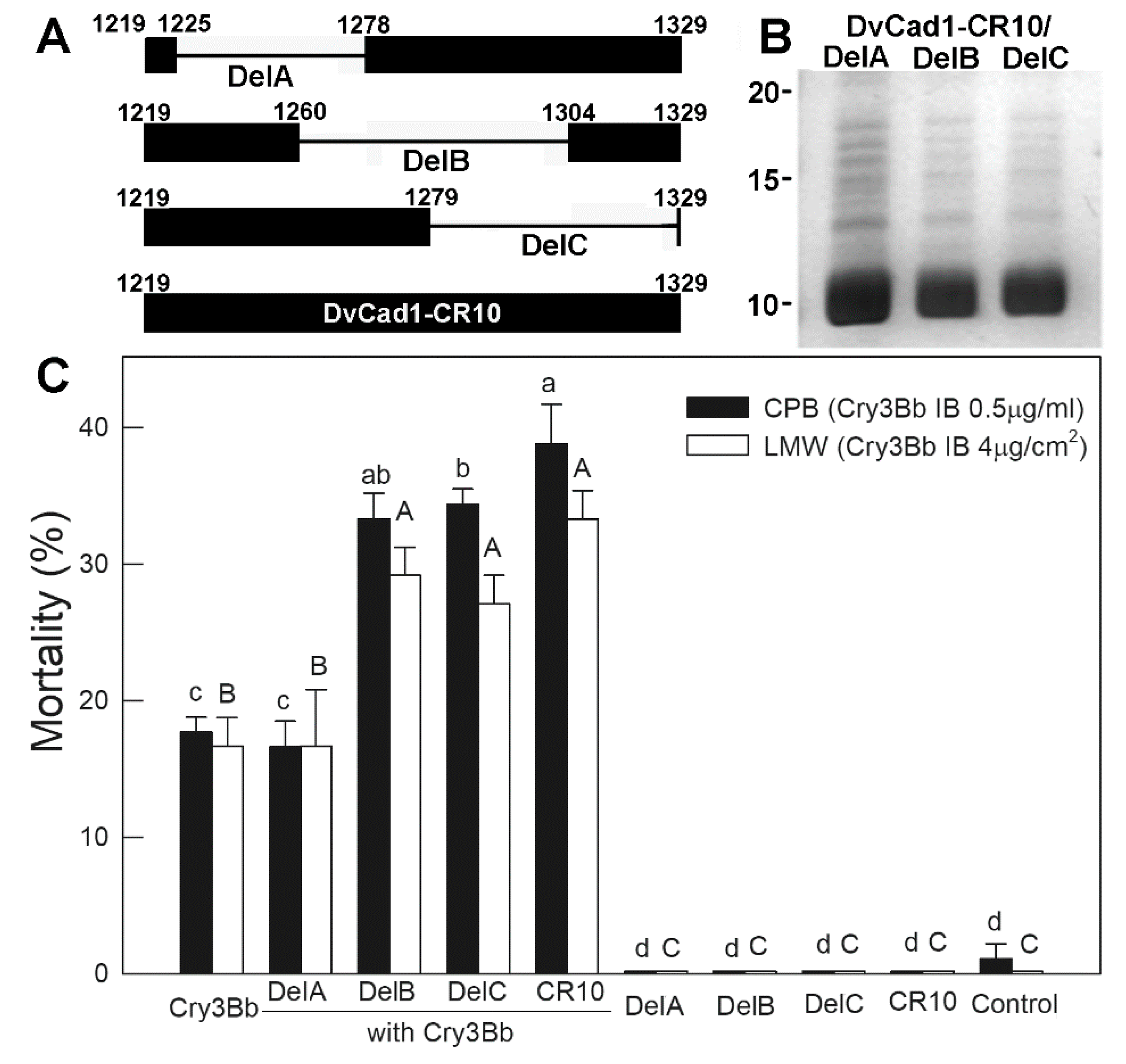
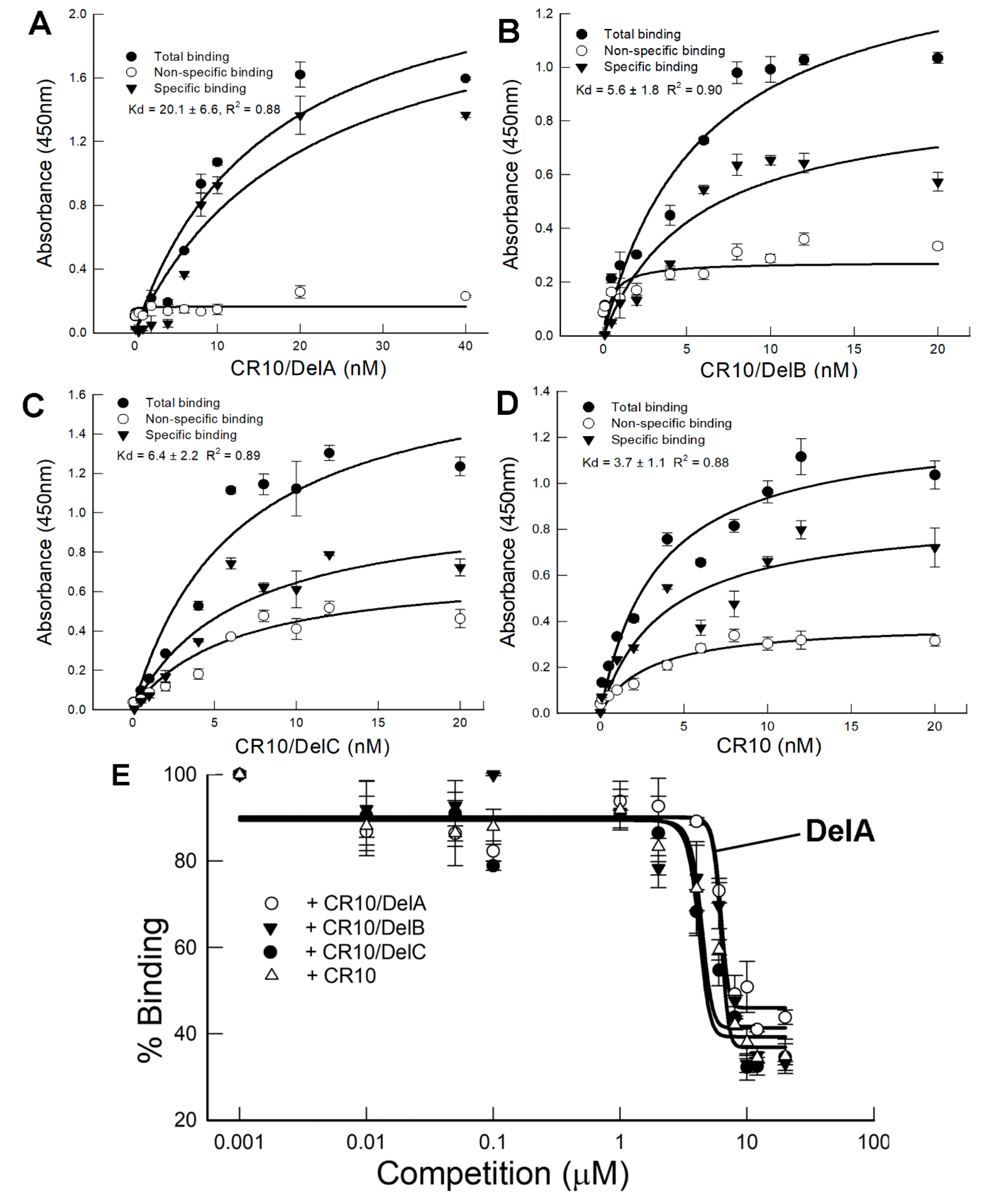
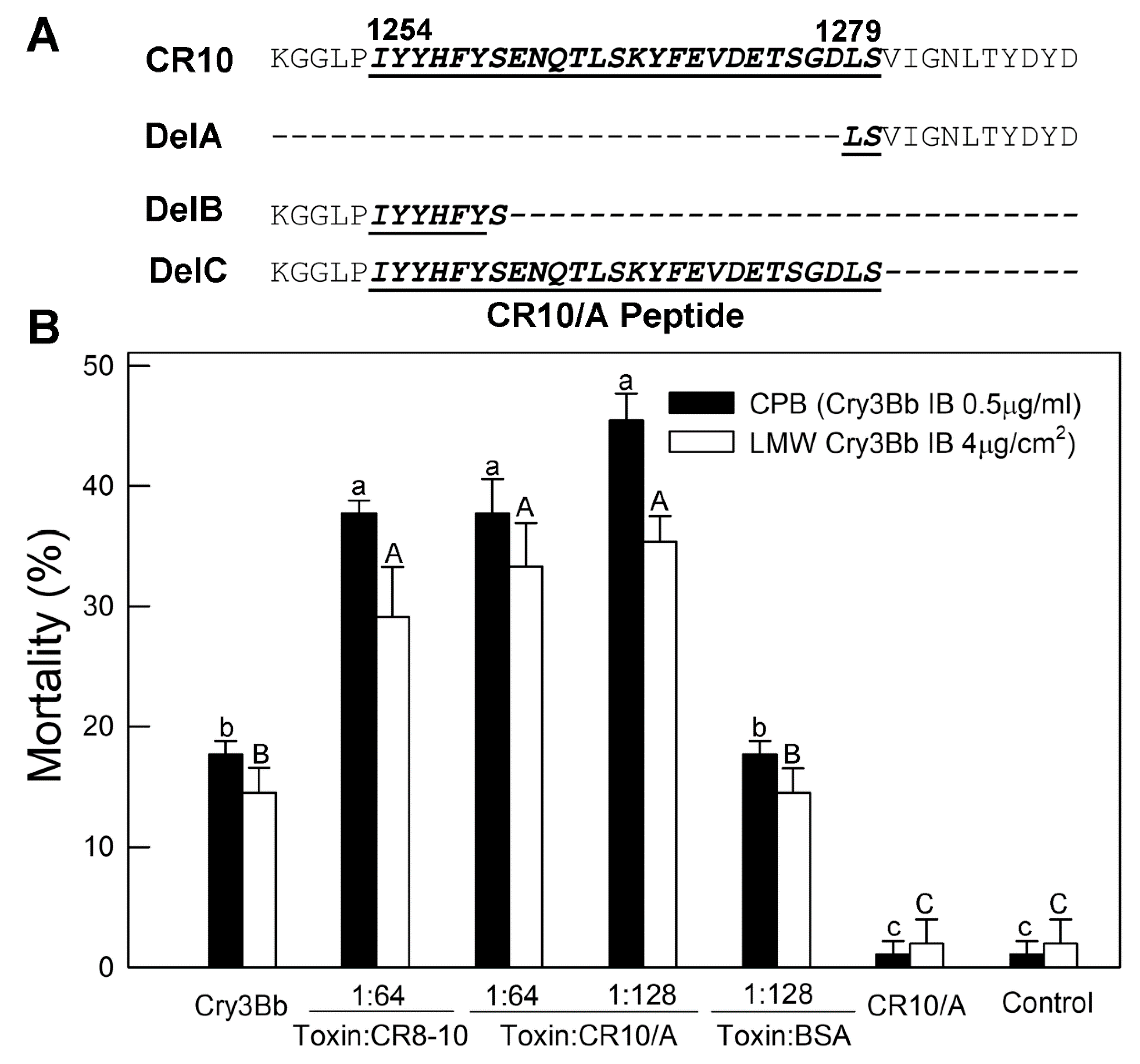
© 2019 by the authors. Licensee MDPI, Basel, Switzerland. This article is an open access article distributed under the terms and conditions of the Creative Commons Attribution (CC BY) license (http://creativecommons.org/licenses/by/4.0/).
Share and Cite
Park, Y.; Hua, G.; Ambati, S.; Taylor, M.; Adang, M.J. Binding and Synergizing Motif within Coleopteran Cadherin Enhances Cry3Bb Toxicity on the Colorado Potato Beetle and the Lesser Mealworm. Toxins 2019, 11, 386. https://doi.org/10.3390/toxins11070386
Park Y, Hua G, Ambati S, Taylor M, Adang MJ. Binding and Synergizing Motif within Coleopteran Cadherin Enhances Cry3Bb Toxicity on the Colorado Potato Beetle and the Lesser Mealworm. Toxins. 2019; 11(7):386. https://doi.org/10.3390/toxins11070386
Chicago/Turabian StylePark, Youngjin, Gang Hua, Suresh Ambati, Milton Taylor, and Michael J. Adang. 2019. "Binding and Synergizing Motif within Coleopteran Cadherin Enhances Cry3Bb Toxicity on the Colorado Potato Beetle and the Lesser Mealworm" Toxins 11, no. 7: 386. https://doi.org/10.3390/toxins11070386
APA StylePark, Y., Hua, G., Ambati, S., Taylor, M., & Adang, M. J. (2019). Binding and Synergizing Motif within Coleopteran Cadherin Enhances Cry3Bb Toxicity on the Colorado Potato Beetle and the Lesser Mealworm. Toxins, 11(7), 386. https://doi.org/10.3390/toxins11070386





